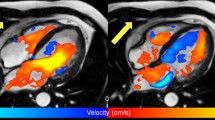Abstract
Four-dimensional flow magnetic resonance imaging (4D Flow MRI) enables visualization of intra-cardiac blood flow and quantification of cardiac function using time-resolved three directional velocity data. Segmentation of cardiac 4D flow data is a big challenge due to the extremely poor contrast between the blood pool and myocardium. The magnitude and velocity images from a 4D flow acquisition provide complementary information, but how to extract and fuse these features efficiently is unknown. Automated cardiac segmentation methods from 4D flow MRI have not been fully investigated yet. In this paper, we take the velocity and magnitude image as the inputs of two branches separately, then propose a Transformer based cross- and self-fusion layer to explore the inter-relationship from two modalities and model the intra-relationship in the same modality. A large in-house dataset of 104 subjects (91,182 2D images) was used to train and evaluate our model using several metrics including the Dice, Average Surface Distance (ASD), end-diastolic volume (EDV), end-systolic volume (ESV), Left Ventricle Ejection Fraction (LVEF) and Kinetic Energy (KE). Our method achieved a mean Dice of 86.52%, and ASD of 2.51 mm. Evaluation on the clinical parameters demonstrated competitive results, yielding a Pearson correlation coefficient of 83.26%, 97.4%, 96.97% and 98.92% for LVEF, EDV, ESV and KE respectively. Code is available at github.com/xsunn/4DFlowLVSeg.
Access this chapter
Tax calculation will be finalised at checkout
Purchases are for personal use only
Similar content being viewed by others
References
Tao, Q., et al.: Deep learning-based method for fully automatic quantification of left ventricle function from cine MR images: a multivendor, multicenter study. Radiology 290(1), 81–88 (2019)
Bai, W., et al.: Automated cardiovascular magnetic resonance image analysis with fully convolutional networks. J. Cardiovasc. Magn. Reson. 20(1), 1–12 (2018). https://doi.org/10.1186/s12968-018-0471-x
Garg, P., et al.: Left ventricular blood flow kinetic energy after myocardial infarction-insights from 4D flow cardiovascular magnetic resonance. J. Cardiovasc. Magn. Reson. 20(1), 1–15 (2018). https://doi.org/10.1186/s12968-018-0483-6
Ronneberger, O., Fischer, P., Brox, T.: U-Net: convolutional networks for biomedical image segmentation. In: Navab, N., Hornegger, J., Wells, W.M., Frangi, A.F. (eds.) MICCAI 2015. LNCS, vol. 9351, pp. 234–241. Springer, Cham (2015). https://doi.org/10.1007/978-3-319-24574-4_28
Isensee, F., et al.: nnU-Net: a self-configuring method for deep learning-based biomedical image segmentation. Nat. Methods 18(2), 203–211 (2021)
Vaswani, A., et al.: Attention is all you need. Advances in Neural Information Processing Systems, vol. 30, pp. 5998–6008 (2017)
Dosovitskiy, A., et al.: An image is worth 16x16 words: transformers for image recognition at scale. arXiv preprint arXiv:2010.11929 (2020)
Chen, J., Lu, Y., Yu, Q., Luo, X., et al.: TransUNet: transformers make strong encoders for medical image segmentation. arXiv preprint arXiv:2102.04306 (2021)
Liu, Z., et al.: Swin transformer: hierarchical vision transformer using shifted windows. arXiv preprint arXiv:2103.14030 (2021)
Cao, H., et al.: Swin-Unet: Unet-like pure transformer for medical image segmentation. arXiv preprint arXiv:2105.05537 (2021)
Li, H., et al.: DT-MIL: deformable transformer for multi-instance learning on histopathological image. In: de Bruijne, M., et al. (eds.) MICCAI 2021. LNCS, vol. 12908, pp. 206–216. Springer, Cham (2021). https://doi.org/10.1007/978-3-030-87237-3_20
Luo, Y., et al.: 3D transformer-GAN for high-quality PET reconstruction. In: de Bruijne, M., et al. (eds.) MICCAI 2021. LNCS, vol. 12906, pp. 276–285. Springer, Cham (2021). https://doi.org/10.1007/978-3-030-87231-1_27
Ji, Y., et al.: Multi-compound transformer for accurate biomedical image segmentation. In: de Bruijne, M., et al. (eds.) MICCAI 2021. LNCS, vol. 12901, pp. 326–336. Springer, Cham (2021). https://doi.org/10.1007/978-3-030-87193-2_31
Berhane, H., et al.: Fully automated 3D aortic segmentation of 4D flow MRI for hemodynamic analysis using deep learning. Magn. Reson. Med. 84(4), 2204–2218 (2020)
Wu, Y., et al.: Automated multi-channel segmentation for the 4D myocardial velocity mapping cardiac MR. In: Medical Imaging 2021: Computer-Aided Diagnosis, vol. 11597. International Society for Optics and Photonics (2021)
Garg, P., et al.: Left ventricular thrombus formation in myocardial infarction is associated with altered left ventricular blood flow energetics. Eur. Heart J. Cardiovasc. Imaging 20(1), 108–117 (2019)
Author information
Authors and Affiliations
Corresponding author
Editor information
Editors and Affiliations
1 Electronic supplementary material
Below is the link to the electronic supplementary material.
Rights and permissions
Copyright information
© 2022 The Author(s), under exclusive license to Springer Nature Switzerland AG
About this paper
Cite this paper
Sun, X., Cheng, LH., Plein, S., Garg, P., van der Geest, R.J. (2022). Transformer Based Feature Fusion for Left Ventricle Segmentation in 4D Flow MRI. In: Wang, L., Dou, Q., Fletcher, P.T., Speidel, S., Li, S. (eds) Medical Image Computing and Computer Assisted Intervention – MICCAI 2022. MICCAI 2022. Lecture Notes in Computer Science, vol 13435. Springer, Cham. https://doi.org/10.1007/978-3-031-16443-9_36
Download citation
DOI: https://doi.org/10.1007/978-3-031-16443-9_36
Published:
Publisher Name: Springer, Cham
Print ISBN: 978-3-031-16442-2
Online ISBN: 978-3-031-16443-9
eBook Packages: Computer ScienceComputer Science (R0)





